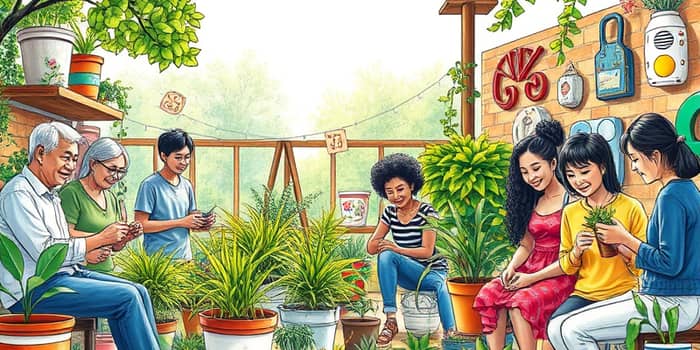In a world grappling with environmental urgency, repurposing and reusing have transcended mere trends—they embody a cultural transformation toward mindful living. This shift invites each of us to see potential in what once was discarded, turning waste into opportunity and consumerism into stewardship. By embracing simple, intentional changes, communities and individuals alike can cultivate joy, resilience, and a profound connection with our planet.
The Statistics Behind the Shift
The momentum driving sustainable behaviors is undeniable. Studies reveal that 72% of global consumers are willing to pay a premium for responsibly produced goods, while 55% of buyers favor eco-friendly brands. American shoppers, in particular, show a readiness to invest up to 11% more for products that minimize environmental impact. Between 2024 and 2032, the green technology market is projected to skyrocket from $17 billion to over $105 billion at a remarkable CAGR of 22.4%.
Data from recent surveys highlight the most widespread individual actions:
These figures, while impressive, represent just the beginning of a cultural revival—where consumers demand transparency, durability, and purpose from every purchase.
The Circular Economy in Action
At the heart of lasting sustainability lies the principle of transition to a circular economy. Rather than a linear “take-make-dispose” model, circular systems aim to keep materials in use for as long as possible. Businesses are redesigning products for durability and reparability, while pioneering startups convert waste streams into valuable resources.
Practical examples abound: manufacturers craft smartphones with modular parts that can be individually replaced; textile brands take back old garments to upcycle fibers; and cafes adopt refillable containers instead of single-use cups. Every innovation chips away at the notion that convenience must cost the earth.
Encouragingly, corporate leaders see strong returns on sustainability investments. A majority of executives expect circular strategies to boost profitability by diverting waste, reducing procurement costs, and unlocking new revenue streams from refurbished or subscription-based services. This mindset shift transforms environmental responsibility into a core business driver, aligning shareholder value with the planet's health.
Everyday Choices: Barriers and Breakthroughs
Despite optimism, barriers persist. Price remains the top concern for 41% of consumers, while unclear labeling stalls 28% from making sustainable purchases. Complex recycling systems, though more accessible than ever, still suffer contamination rates that undercut their effectiveness. Emotionally, many feel overwhelmed by the idea of perfection, fearing that small efforts won’t amount to meaningful impact.
Yet, relief comes in the form of incremental, accessible changes for everyday living. Instead of striving for zero-waste perfection, we can:
- Repurpose glass jars and tin cans as storage containers
- Transform old clothing into cleaning rags or patchwork quilts
- Schedule a weekly “leftover remix” meal to cut food waste
- Swap disposable bags for sturdy, reusable totes
Such actions are not only manageable but also build confidence and momentum. As habits take root, they reveal new possibilities for creativity and conservation.
Water, Waste, and Wider Impacts
Water scarcity threatens an estimated 1.8 billion people by 2025, underscoring the critical link between resource consumption and environmental stability. Corporations and communities globally are stepping up through nature-based solutions, investing in wetland restoration, sustainable agriculture, and urban green infrastructure.
On the waste front, single-stream recycling systems have simplified participation, but contamination can render entire batches unusable. By adopting reducing food waste and saving resources practices, such as portion planning, composting, and mindful shopping, households can alleviate both landfill burden and carbon emissions.
Communities are piloting decentralized wastewater treatment and rainwater harvesting systems, illustrating how small-scale projects can have outsized impact. By prioritizing community-led conservation initiatives, neighborhoods build resilience against droughts and floods, ensuring equitable access to clean water.
Corporate and Market Responses
Businesses are recognizing that sustainability drives innovation, loyalty, and long-term profitability. Major corporations have pledged ambitious targets—PepsiCo aims to replenish over 100% of the water it uses in high-risk areas by 2030, while global apparel giants are increasing recycled content in their products year over year.
- Brands integrating upcycled materials into product lines
- Tech firms leveraging AI for carbon footprint tracking and optimization
- Retailers expanding zero-waste storefronts and refill stations
Meanwhile, the green tech and sustainability sector is exploding, projected to grow over sixfold by 2032. Investments in investment in nature-based solutions are forecast to surpass $384 billion annually by 2025, channeling funds into reforestation, regenerative agriculture, and coral reef restoration. Such initiatives blur the line between ecological preservation and financial opportunity, inviting investors to support projects that yield both environmental and economic dividends.
The Rejoicing: Wellbeing and Social Value
Beyond ecological benefits, repurposing and reusing foster a profound sense of satisfaction and community. Transforming a chipped mug into a succulent planter, assembling furniture from reclaimed wood, or organizing a neighborhood swap event can spark joy and social connection.
Studies show that participating in collective sustainability projects reduces stress and builds resilience. Sharing skills—be it sewing, repairing, or composting—strengthens social bonds and creates a shared narrative of hope and progress.
Looking Forward: A Sustainable, Joyful Future
As we embrace the principles of repair, reuse, and rejoicing, each choice radiates outward, inspiring others to join the movement. Our collective actions can slow climate change, conserve water, and preserve biodiversity, all while enriching our daily lives. The pathway to sustainability is not a solitary sprint but a communal journey—one where creativity, compassion, and ingenuity guide us toward a thriving planet.
Emerging trends such as carbon labeling on consumer products, AI-driven supply chain optimization, and digital platforms facilitating peer-to-peer recycling exchanges will further democratize sustainability. These innovations ensure that every decision—from buying groceries to choosing electronics—can be guided by transparent environmental data, making it easier than ever to align daily habits with global goals.
Whether you start by turning old t-shirts into tote bags or championing corporate responsibility in your workplace, remember that every step counts. Together, we can repurpose not only materials but also our values, refashioning a future where joy and justice go hand in hand.
References
- https://www.arbor.eco/blog/sustainability-statistics
- https://theroundup.org/environmentally-conscious-consumer-statistics/
- https://greenplaces.com/articles/50-essential-sustainability-statistics-for-2025/
- https://www.travelperk.com/blog/business-sustainability-statistics/
- https://nmisolutions.com/research-reports/sustainability-reports/2025-sustainability-consumer-research/
- https://www.itmustbenow.com/feature/the-now-team-blog/ten-sustainability-trends-2025/
- https://www.goingzerowaste.com/blog/three-reasons-the-trash-jar-is-bullsht/










